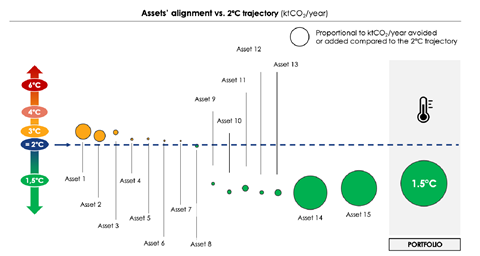Organisation details
- Name: Infranity
- Signatory type: Investment manager
- HQ location: Paris
- Operating region: Europe
- Assets under management: €7 billion[1]
Covered in this case study
- Asset class: Infrastructure
We invest our €7 billion AUM in sustainable investments that provide a stable source of yield and resilience across economic cycles and that create positive social and environmental outcomes. We determine these using a systematic ESG assessment that is fully embedded in our investment decision process.
Why we assess the carbon performance of our assets and portfolios
The Paris Agreement has set clear long-term goals: to substantially reduce global greenhouse gas emissions to limit the global temperature increase to below 2°C by 2100.
To meet these, financing needs to be urgently directed towards infrastructure that will support the low-carbon transition. Given the long-term nature of infrastructure assets, the choices made today are bound to have a decisive long-term impact on climate.
As long-term infrastructure investors, we committed to aligning our global portfolio with the Paris Agreement targets in 2021 and to maintaining this alignment over time. Moreover, many of our institutional investors are requesting that their portfolios be aligned with these objectives.
We use the methodology discussed below to help inform our investment decisions and to establish the link between portfolios and climate change. In this way, we can design financial products that meet the Paris Agreement targets.
Beyond determining if assets and portfolios perform better or worse than the 2°C benchmark as defined by the Paris Agreement, we assess investments in detail at each level to estimate key carbon data such as absolute emissions, carbon footprint and intensity.
This also allows us to identify how exposed assets are to transition risks, by determining which investees are the biggest emitters of greenhouse gases.
How we assess carbon performance of our assets and portfolios
Alongside other investors, we supported the energy transition and climate change advisory firm Carbone4 to create Climate Impact Analytics for Real Assets (CIARA), a target-setting methodology to reduce the emission intensity of assets and portfolios based on sectoral carbon budgets.
CIARA compares the carbon intensity indicator of an asset, such as CO2/kWh for power, against the value of the same indicator in different climate scenarios, based on how the infrastructure could potentially perform when being used.
The climate scenarios are based on the global carbon budgets defined by the Intergovernmental Panel on Climate Change, which are then allocated by country and sector.
We evaluate each asset’s carbon performance using CIARA when we invest in it and on a yearly basis thereafter. By tracking data on a regular and systematic basis, we intend to capture how the climate performance of an asset evolves and if it deviates significantly from our targets. In that case, we engage with the investee to see how we can improve its climate performance.
Once we obtain the temperature and emissions performance of the assets, we aggregate them at the portfolio and firm level, to determine how they align with the 2°C target at each level.
In summary, our climate performance assessment consists of six steps:
Step 1: We assess the forward-looking performance of assets based on their key physical data, such as the amount of energy produced or consumed or the amount of waste processed, and on reference data, such as emissions factors.
Step 2: We identify how the assets will be used – for example, the electricity generated by a power plant may be used for heating, transportation, or lighting.
Step 3: We calculate the carbon performance for each end-use.
Step 4: We estimate how each end-use might change over time – for example, if the proportion of electricity used for heating is likely to increase or decrease – to calculate its average share for the asset.
Step 5: We compare and rate each asset against a 2°C scenario.
Step 6: We aggregate the performance of all assets to deliver a final rating at the portfolio level.
Figure 1: Example of how assets in a fund align with a 2°C-trajectory using CIARA

Example: Assessing the carbon performance of a wind farm
We participated in the financing of a wind farm portfolio in France in 2021.
The end-uses of the power generated by the wind farm included specific electricity (such as lighting), heating, transportation and industrial uses.
For each end-use, the CO2 intensity of the power produced by the wind farm was compared with the targeted CO2 intensity for each sector, as defined by Carbone4 in its decarbonisation scenarios.
The wind farm performed better than the decarbonisation scenarios used: for a given amount of energy produced, it emitted less than what was required to be aligned with 2°C.
More specifically, based on the physical carbon budgets, it aligned with a 1.6°C trajectory, meaning that if all end-uses were powered by energy with the same level of carbon intensity as this wind farm generated, the total emissions would correspond to a global temperature rise of 1.6°C.
As a result, the investment was efficient from a carbon performance perspective and contributed positively to our firm- and fund-wide alignment with 2°C.
We had expected the wind farm to be aligned with the Paris Agreement. However, the results of the climate performance assessment helped inform our investment decision, by showing us how much it would help our fund improve its overall trajectory.
Overall, the methodology is key for our portfolio construction, especially for assets that are not as straightforward as a wind farm, as it allows us to identify how any new investment may impact the 2°C alignment of our portfolio.
References
[1] As of October 2022












